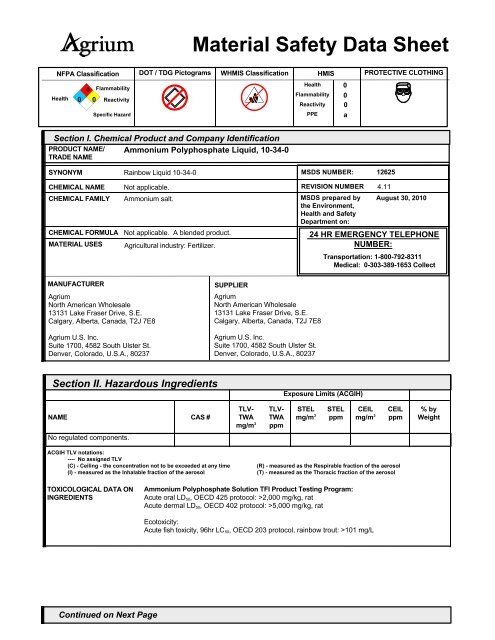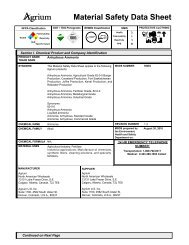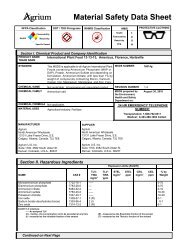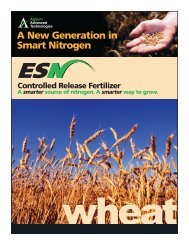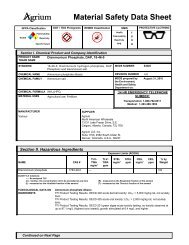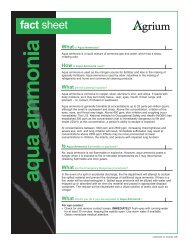MSDS - Agrium
MSDS - Agrium
MSDS - Agrium
You also want an ePaper? Increase the reach of your titles
YUMPU automatically turns print PDFs into web optimized ePapers that Google loves.
Material Safety Data Sheet<br />
NFPA Classification<br />
DOT / TDG Pictograms<br />
WHMIS Classification<br />
HMIS<br />
PROTECTIVE CLOTHING<br />
Health<br />
0<br />
0 Flammability<br />
0 Reactivity<br />
Specific Hazard<br />
Health<br />
Flammability<br />
Reactivity<br />
PPE<br />
0<br />
0<br />
0<br />
a<br />
Section I. Chemical Product and Company Identification<br />
PRODUCT NAME/ Ammonium Polyphosphate Liquid, 10-34-0<br />
TRADE NAME<br />
SYNONYM<br />
Rainbow Liquid 10-34-0<br />
<strong>MSDS</strong> NUMBER:<br />
12625<br />
CHEMICAL NAME<br />
CHEMICAL FAMILY<br />
CHEMICAL FORMULA<br />
MATERIAL USES<br />
Not applicable.<br />
Ammonium salt.<br />
Not applicable. A blended product.<br />
Agricultural industry: Fertilizer.<br />
REVISION NUMBER 4.11<br />
<strong>MSDS</strong> prepared by<br />
the Environment,<br />
Health and Safety<br />
Department on:<br />
August 30, 2010<br />
24 HR EMERGENCY TELEPHONE<br />
NUMBER:<br />
Transportation: 1-800-792-8311<br />
Medical: 0-303-389-1653 Collect<br />
MANUFACTURER<br />
<strong>Agrium</strong><br />
North American Wholesale<br />
13131 Lake Fraser Drive, S.E.<br />
Calgary, Alberta, Canada, T2J 7E8<br />
<strong>Agrium</strong> U.S. Inc.<br />
Suite 1700, 4582 South Ulster St.<br />
Denver, Colorado, U.S.A., 80237<br />
SUPPLIER<br />
<strong>Agrium</strong><br />
North American Wholesale<br />
13131 Lake Fraser Drive, S.E.<br />
Calgary, Alberta, Canada, T2J 7E8<br />
<strong>Agrium</strong> U.S. Inc.<br />
Suite 1700, 4582 South Ulster St.<br />
Denver, Colorado, U.S.A., 80237<br />
Section II. Hazardous Ingredients<br />
Exposure Limits (ACGIH)<br />
NAME CAS #<br />
TLV-<br />
TWA<br />
mg/m 3<br />
TLV-<br />
TWA<br />
ppm<br />
STEL<br />
mg/m 3<br />
STEL<br />
ppm<br />
CEIL<br />
mg/m 3<br />
CEIL<br />
ppm<br />
% by<br />
Weight<br />
No regulated components.<br />
ACGIH TLV notations:<br />
---- No assigned TLV<br />
(C) - Ceiling - the concentration not to be exceeded at any time (R) - measured as the Respirable fraction of the aerosol<br />
(I) - measured as the Inhalable fraction of the aerosol (T) - measured as the Thoracic fraction of the aerosol<br />
TOXICOLOGICAL DATA ON<br />
INGREDIENTS<br />
Ammonium Polyphosphate Solution TFI Product Testing Program:<br />
Acute oral LD 50, OECD 425 protocol: >2,000 mg/kg, rat<br />
Acute dermal LD 50, OECD 402 protocol: >5,000 mg/kg, rat<br />
Ecotoxicity:<br />
Acute fish toxicity, 96hr LC 50, OECD 203 protocol, rainbow trout: >101 mg/L<br />
Continued on Next Page
Ammonium Polyphosphate Liquid, 10-34-0 Page Number: 2<br />
Section III. Hazards Identification.<br />
POTENTIAL ACUTE HEALTH<br />
EFFECTS<br />
POTENTIAL CHRONIC<br />
HEALTH EFFECTS<br />
This product may irritate eyes and skin upon prolonged or repeated contact. Over-exposure<br />
by inhalation may cause respiratory tract irritation. Ingestion of this substance may produce<br />
irritation of the gastro-intestinal tract, characterized by burning and diarrhea.<br />
CARCINOGENIC EFFECTS: NONE by ACGIH, EPA, IARC, NTP, OSHA.<br />
MUTAGENIC EFFECTS: NONE by ACGIH, EPA, IARC, NTP, OSHA.<br />
TERATOGENIC EFFECTS: NONE by ACGIH, EPA, IARC, NTP, OSHA.<br />
There is no known effect from chronic exposure to this product.<br />
Section IV. First Aid Measures<br />
EYE CONTACT<br />
May cause eye irritation. Check for and remove any contact lenses. Immediately flush eyes<br />
with running water for at least 15 minutes, keeping eyelids open. Obtain medical attention if<br />
irritation persists.<br />
MINOR SKIN CONTACT<br />
EXTENSIVE SKIN CONTACT<br />
May cause skin irritation. Wash contaminated skin with soap and water. Cover dry or irritated<br />
skin with a good quality skin lotion. If irritation persists, seek medical attention. Wash<br />
contaminated clothing before reusing.<br />
No additional information.<br />
MINOR INHALATION<br />
SEVERE INHALATION<br />
SLIGHT INGESTION<br />
Repeated or prolonged inhalation of mists may lead to respiratory irritation. Loosen tight<br />
clothing around the individual's neck and waist. Allow the person to rest in a well ventilated<br />
area. Obtain medical attention if irritation persists.<br />
No additional remark.<br />
Do not induce vomiting. Low toxicity. May cause digestive tract irritation, with accompanying<br />
nausea, vomiting and diarrhea. If spontaneous vomiting does occur, lower the head so that<br />
the vomit will not reenter the mouth and throat.<br />
If tolerated, give no more than 1 cup of milk or water for adults or 1/2 cup for children to rinse<br />
the mouth and throat, dilute the stomach contents, and minimize irritation. Obtain medical<br />
attention if irritation persists.<br />
EXTENSIVE INGESTION<br />
No additional information.<br />
Section V. Fire and Explosion Data<br />
THE PRODUCT IS<br />
Non-flammable.<br />
AUTO-IGNITION<br />
TEMPERATURE<br />
FLASH POINT<br />
FLAMMABILITY LIMITS<br />
PRODUCTS OF<br />
COMBUSTION<br />
FIRE HAZARD IN THE<br />
PRESENCE OF VARIOUS<br />
SUBSTANCES<br />
EXPLOSION HAZARD IN THE<br />
PRESENCE OF VARIOUS<br />
SUBSTANCES<br />
FIRE FIGHTING MEDIA AND<br />
INSTRUCTIONS<br />
Not applicable.<br />
Not applicable.<br />
Not applicable.<br />
Material will not burn, but thermal decomposition may result in flammable/toxic gases being<br />
formed after material evaporated to dryness. These products are nitrogen oxides and<br />
ammonia (NO, NO 2, NH 3).<br />
Not applicable.<br />
This product is non-explosive.<br />
Non-flammable. Use extinguishing media suitable for surrounding materials.<br />
Continued on Next Page
Ammonium Polyphosphate Liquid, 10-34-0 Page Number: 3<br />
SPECIAL REMARKS ON<br />
FIRE HAZARDS<br />
Non combustible. Flammable/toxic gases may form at elevated temperatures (>100 °C) by<br />
thermal decomposition (ammonia, phosphorus oxides, nitrogen oxides). Avoid temperatures<br />
above 100°C (212°F). On evaporation to dryness thermal decomposition may result.<br />
SPECIAL REMARKS ON<br />
EXPLOSION HAZARDS<br />
No additional remark.<br />
Section VI. Accidental Release Measures<br />
SMALL SPILL<br />
LARGE SPILL<br />
Absorb with an inert material and place in an appropriate waste disposal container. Ensure<br />
disposal complies with local regulations.<br />
In the event of a spill, stop leak if possible to do so without risk. Dike and contain spilled<br />
material. Ensure that the spilled material does not enter sewers, wells, or watercourses.<br />
Product will promote algae growth which may degrade water quality and taste. Notify<br />
downstream water users. Pump up spilled material and place in suitable containers for reuse<br />
or disposal. Ensure disposal complies with local regulations.<br />
Section VII. Handling and Storage<br />
PRECAUTIONS<br />
STORAGE<br />
After handling, always wash hands thoroughly with soap and water. Avoid contact with skin<br />
and eyes. Keep away from food, drink and animal feed. Avoid contact with incompatable<br />
substances, particularly alkaline substances like caustic soda. Ensure previous containers<br />
and transport equipment containing strong alkali are thoroughly cleaned before adding 10-34-<br />
0 solution. Keep out of reach of children.<br />
Keep in a cool, well-ventilated location.<br />
Section VIII. Exposure Controls/Personal Protection<br />
ENGINEERING CONTROLS Use process enclosures, local exhaust ventilation, or other engineering controls to keep<br />
airborne levels below recommended exposure limits. If user operations generate mists, use<br />
ventilation to keep exposure to airborne contaminants below the exposure limit.<br />
PERSONAL PROTECTION<br />
PERSONAL PROTECTION IN<br />
CASE OF LARGE RELEASE<br />
The selection of personal protective equipment varies, depending upon conditions of use.<br />
Wear appropriate respiratory protection for dust/mist when ventilation is inadequate. A filtering<br />
facepiece dust mask is recommended for most applications if respiratory protection is<br />
needed. Where skin and eye contact may occur as a result of brief periodic exposures, wear<br />
long sleeved clothing, coveralls, chemical resistant gloves, and safety glasses with side<br />
shields.<br />
No additional information.<br />
EXPOSURE LIMITS<br />
Alberta TWA: 10 mg/m 3 Inhalable, 3 mg/m 3 Respirable, for Particulate Not Otherwise<br />
Regulated.<br />
Fed OSHA PEL: 15 mg/m 3 Total dust, 5 mg/m 3 Respirable fraction, for Particulates Not<br />
Otherwise Regulated.<br />
Federal, State or Provincial exposure limits may vary by jurisdiction. Consult local authorities<br />
for acceptable exposure limits in your area.<br />
Section IX. Physical and Chemical Properties<br />
PHYSICAL STATE AND<br />
APPEARANCE<br />
MOLECULAR WEIGHT<br />
Liquid. (Clear to slightly hazy liquid.)<br />
Not available.<br />
COLOR<br />
Clear green.<br />
pH (10% SOLN/WATER)<br />
BOILING POINT<br />
7<br />
100 °C<br />
ODOR<br />
ODOR<br />
THRESHOLD<br />
Odorless.<br />
17 PPM (Ammonia)<br />
MELTING POINT<br />
-18°C (-0.4°F)<br />
TASTE<br />
Acid. Saline.<br />
CRITICAL TEMPERATURE<br />
Not available.<br />
VOLATILITY<br />
Not available.<br />
Continued on Next Page
Ammonium Polyphosphate Liquid, 10-34-0 Page Number: 4<br />
SPECIFIC GRAVITY g/cc<br />
VAPOR PRESSURE<br />
1.4 (Water = 1)<br />
BULK DENSITY<br />
kg/m 3 ; lbs/ft 3 1400 kg/m 3 ; 87.4 lbs/ft 3 ;<br />
11.7 lbs/gal (US).<br />
Not available.<br />
SOLUBILITY<br />
DISPERSION<br />
PROPERTIES<br />
WATER/OIL DIST.<br />
COEFF.<br />
Easily soluble in cold water, hot<br />
water.<br />
Easily dispersed in any proportion in<br />
cold water and hot water.<br />
Not available.<br />
VAPOR DENSITY<br />
Not available.<br />
Section X. Stability and Reactivity Data<br />
STABILITY<br />
The product is stable.<br />
INSTABILITY<br />
TEMPERATURE<br />
CONDITIONS OF<br />
INSTABILITY<br />
INCOMPATABILITY WITH<br />
VARIOUS SUBSTANCES<br />
CORROSIVITY<br />
Not available.<br />
No additional remark.<br />
Very slightly reactive with metals. Very reactive with strong alkaline substances like caustic<br />
soda, producing ammonia gas and heat with the possibility of the mixture boiling over and<br />
splashing.<br />
Slightly corrosive to copper, iron, and steel.<br />
SPECIAL REMARKS ON<br />
REACTIVITY<br />
SPECIAL REMARKS ON<br />
CORROSIVITY<br />
No additional remark.<br />
Incompatible with copper alloys. Corrosive to brass. Corrosive to ferrous metals and alloys.<br />
Contact your sales representative or a metallurgical specialist to ensure compatability with<br />
system equipment.<br />
Section XI. Toxicological Information<br />
SIGNIFICANT ROUTES OF<br />
EXPOSURE<br />
TOXICITY TO ANIMALS<br />
SPECIAL REMARKS ON<br />
TOXICITY TO ANIMALS<br />
OTHER EFFECTS ON<br />
HUMANS<br />
Ingestion. Inhalation.<br />
See Section II.<br />
Will release ammonium ions. Ammonia is a toxic hazard to fish. The product itself and its<br />
products of degradation are not harmful under normal conditions of use. May be harmful to<br />
livestock and wildlife if ingested. Clean up all spilled material, especially where bulk fertilizer<br />
loading of equipment occurs.<br />
Our data base contains no additional remark on the toxicity of this product<br />
SPECIAL REMARKS ON<br />
CHRONIC EFFECTS ON<br />
HUMANS<br />
SPECIAL REMARKS ON<br />
OTHER EFFECTS ON<br />
HUMANS<br />
No additional remark.<br />
No additional remark.<br />
Section XII. Ecological Information<br />
ECOTOXICITY<br />
Non-persistent. Non-cumulative when applied using normal agricultural practices. May be<br />
harmful to fish, livestock, and wildlife. Dissolved mineral salts may cause irritation of the<br />
digestive tract.<br />
Aquatic/Marine Toxicity: Will release ammonium ions. Ammonia is a toxic hazard to fish.<br />
Will release phosphate. Phosphates will result in algae growth which may increase turbidity<br />
and deplete oxygen resulting in a hazard to fish or other marine organisms. Will disperse with<br />
the current. Release to watercourses may cause effects down stream from the point of<br />
release. Avoid spills or release to watercourses. U.S. D.O.T.: This material NOT listed as a<br />
Marine pollutant.<br />
Continued on Next Page
Ammonium Polyphosphate Liquid, 10-34-0 Page Number: 5<br />
BOD and COD<br />
PRODUCTS OF<br />
DEGRADATION<br />
TOXICITY OF THE<br />
PRODUCTS OF<br />
DEGRADATION<br />
SPECIAL REMARKS ON THE<br />
PRODUCTS OF<br />
DEGRADATION<br />
Not available.<br />
Nitrogen oxides (NO,NO 2...). Phosphates. Inorganic mineral salts and oxides.<br />
The products of biodegradation are not harmful under normal conditions of slow metabolic<br />
release.<br />
Product will promote algae growth which may degrade water quality and taste. Notify<br />
downstream water users. Will disperse in water. Reclaiming material may not be viable.<br />
Section XIII. Disposal Considerations<br />
WASTE DISPOSAL OR<br />
RECYCLING<br />
Pump up spilled material and place in suitable containers for reuse or disposal. Call for<br />
information on disposal alternatives. Ensure disposal complies with local regulations.<br />
Section XIV. Transport Information<br />
DOT / TDG CLASSIFICATION<br />
Not controlled under DOT (US) or TDG (Canada).<br />
PIN and Shipping Name<br />
Not applicable.<br />
SPECIAL PROVISIONS FOR<br />
TRANSPORT<br />
Not applicable.<br />
DOT (U.S.A) (Pictograms)<br />
Section XV. Other Regulatory Information and Pictograms<br />
OTHER REGULATIONS<br />
CANADIAN ENVIRONMENTAL PROTECTION ACT (CEPA): This product is on the Domestic<br />
Substances List (DSL), and acceptable for use under the provisions of CEPA.<br />
TSCA (Toxic Substance Control Act): This product is listed on the TSCA Inventory.<br />
CERCLA/SUPERFUND, 40 CFR 117,302: This product contains no Reportable Quantity (RQ)<br />
Substances.<br />
This material contains the following chemicals subject to the reporting requirements of SARA 313 and<br />
40 CFR 372:<br />
Aqueous ammonia from water dissociable ammonium ions: 14wt% (includes aqueous ammonia<br />
from water dissociable ammonium salts and other sources, 10% of which is reportable under this<br />
listing) as CAS# 68333-79-9. Refer to the specific product analysis for your product, and EPA<br />
Document 745-R-00-005 to determine your reporting requirements under this regulation.<br />
This product is not considered as a priority pollutant as regulated under the Clean Water Act.<br />
This product has been classified in accordance with the hazard criteria of the Controlled Products<br />
Regulations and is not subject to control under WHMIS (Canada), or the Hazcom Standard (US).<br />
OTHER CLASSIFICATIONS<br />
HCS (U.S.A.)<br />
DSCL (EEC)<br />
Not controlled under the HCS (United States).<br />
Not controlled under DSCL (Europe).<br />
National Fire Protection<br />
Association (U.S.A.)<br />
Hazards presented under acute emergency<br />
conditions only:<br />
Health<br />
0<br />
0<br />
0<br />
Fire Hazard<br />
Reactivity<br />
Specific Hazard<br />
TDG (Pictograms -<br />
Canada)<br />
Continued on Next Page
Ammonium Polyphosphate Liquid, 10-34-0 Page Number: 6<br />
DSCL (Europe)<br />
(Pictograms)<br />
ADR (Europe)<br />
(Pictograms)<br />
Section XVI. Other Information<br />
REFERENCES<br />
-Transportation of Dangerous Goods Act and Clear Language Regulations, current revision.<br />
-Canada Gazette Part II, Vol. 122, No. 2 Registration SOR/88-64 31 December, 1987<br />
Hazardous Products Act "Ingredient Disclosure List".<br />
-Domestic Substances List, Canadian Environmental Protection Act.<br />
-29 CFR Part 1910<br />
-33 CFR Parts 151, 153, 154, 156<br />
-40 CFR Parts 1-799<br />
-46 CFR Part 153<br />
-49 CFR Parts 1-199<br />
-American Conference of Governmental Industrial Hygienists, Threshold Limit Values for<br />
Chemical Substances, 2009.<br />
-NFPA 704, National Fire Codes Online, National Fire Protection Association, current edition at<br />
time of <strong>MSDS</strong> preparation.<br />
-Corrosion Data Survey, Sixth Edition, 1985, National Association of Corrosion Engineers<br />
-ERG2008 Emergency Response Guidebook<br />
-CHRIS Hazardous Chemical Data: U.S. Coast Guard, Washington, D.C.<br />
-HSDB: Hazardous Substances Data Bank. National Library of Medicine, Bethesda,<br />
Maryland<br />
-IRIS: Integrated Risk Information System. U.S. Environmental Protection Agency,<br />
Washington, D.C.<br />
-NIOSH: Pocket Guide to Chemical Hazards. National Institute for Occupational<br />
Safety and Health, Cincinnati, Ohio<br />
-OHM/TADS: Oil and Hazardous Materials Technical Assistance Data System<br />
U.S. Environmental Protection Agency, Washington, D.C.<br />
- RTECS®: Registry of Toxic Effects of Chemical Substances National Institute for<br />
Occupational Safety and Health, Cincinnati, Ohio<br />
-The Fertilizer Institute Product Testing Program Results, March 2003<br />
OTHER SPECIAL<br />
CONSIDERATIONS<br />
24 Hr Medical Emergency Contact Number changed.<br />
FOR FURTHER SAFETY, HEALTH, OR<br />
ENVIRONMENTAL INFORMATION ON<br />
THIS PRODUCT, CONTACT<br />
AGRIUM<br />
Wholesale Environment, Health and Safety<br />
Telephone (780) 998-6906 or Fax (780) 998-6677<br />
NOTICE TO READER<br />
The buyer assumes all risk in connection with the use of this material. The buyer assumes all responsibility for<br />
ensuring this material is used in a safe manner in compliance with applicable environmental, health and safety laws,<br />
policies and guidelines. <strong>Agrium</strong> assumes no responsibility or liability for the information supplied on this sheet,<br />
including any damages or injury caused thereby. <strong>Agrium</strong> does not warrant the fitness of this material for any<br />
particular use and assumes no responsibility for injury or damage caused directly or indirectly by or related to the use<br />
of the material. The information contained in this sheet is developed from what <strong>Agrium</strong> believes to be accurate<br />
and reliable sources, and is based on the opinions and facts available on the date of preparation.


